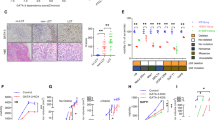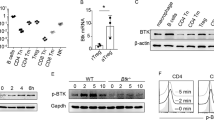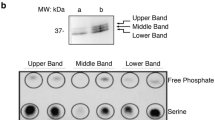Abstract
Upon interaction with its ligand, B7, CD28 becomes phosphorylated on tyrosines. One tyrosine in particular (Y170 in mouse CD28, Y173 in human CD28) has received much attention. This is because it permits CD28 to recruit SH2-containing signaling molecules, including phosphoinositide 3 kinase, Grb2 and Gads. Using mice we employed a transgenic approach to express a tyrosine→phenylalanine mutant form of CD28 that uncouples these SH2-mediated interactions from CD28. The CD28 mutant is unable to up-regulate expression of the prosurvival protein Bcl-xL, rendering the T cells more susceptible to radiation-induced death. Nonetheless, this mutated form of CD28 still prevents the induction of anergy and promotes T cell proliferation, interleukin 2 secretion and B cell help. Thus, we describe a single point mutation within the CD28 cytoplasmic domain that uncouples signals required for proliferation and survival.
This is a preview of subscription content, access via your institution
Access options
Subscribe to this journal
Receive 12 print issues and online access
$209.00 per year
only $17.42 per issue
Buy this article
- Purchase on Springer Link
- Instant access to full article PDF
Prices may be subject to local taxes which are calculated during checkout







Similar content being viewed by others
References
Lenschow, D. J., Walunas, T. L. & Bluestone, J. A. CD28/B7 system of T cell costimulation. Annu. Rev. Immunol. 14, 233–258 (1996).
King, P. D. et al. Analysis of CD28 cytoplasmic tail tyrosine residues as regulators and substrates for the protein tyrosine kinases, EMT and LCK. J. Immunol. 158, 580–590 (1997).
Raab, M. et al. p56Lck and p59Fyn regulate CD28 binding to phosphatidylinositol 3-kinase, growth factor receptor-bound protein GRB-2, and T cell-specific protein-tyrosine kinase ITK: Implications for T-cell costimulation. Proc. Natl Acad. Sci. USA 92, 8891–8895 (1995).
Sadra, A. et al. Identification of tyrosine phosphorylation sites in the CD28 cytoplasmic domain and their role in the costimulation of Jurkat T cells. J. Immunol. 162, 1966–1973 (1999).
Pages, F. et al. Binding of phosphatidylinositol-3-OH kinase to CD28 is required for T-cell signalling. Nature 369, 327–329 (1994).
Hutchcroft, J. E. & Bierer, B. E. Activation-dependent phosphorylation of the T-lymphocyte surface receptor CD28 and associated proteins. Proc. Natl Acad. Sci. USA 91, 3260–3264 (1994).
Prasad, K. V. S. et al. T-cell antigen CD28 interacts with the lipid kinase phosphatidylinositol 3-kinase by a cytoplasmic Tyr(P)-Met-Xaa-Met motif. Proc. Natl Acad. Sci. USA. 91, 2834–2838 (1994).
Stein, P. H., Fraser, J. D. & Weiss, A. The cytoplasmic domain of CD28 is both necessary and sufficient for costimulation of interleukin-2 secretion and association with phosphatidylinositol 3′-kinase. Mol. Cell. Biol. 14, 3392–3402 (1994).
Truitt, K. E., Hicks, C. M. & Imboden, J. B. Stimulation of CD28 triggers an association between CD28 and phosphatidylinositol 3-kinase in Jurkat T cells. J. Exp. Med. 179, 1071–1076 (1994).
August, A. & Dupont, B. CD28 of T lymphocytes associates with phosphatidylinositol 3-kinase. Int. Immunol. 6, 769–774 (1994).
Schneider, H., Cai, Y.-C., Prasad, K. V. S., Shoelson, S. E. & Rudd, C. E. T cell antigen CD28 binds to the GRB-2/SOS complex, regulators of p21ras. Eur. J. Immunol. 25, 1044–1050 (1995).
Vanhaesebroeck, B., Leevers, S. J., Panayotou, G. & Waterfield, M. D. Phosphoinositide 3-kinases: a conserved family of signal transducers. Trends. Biochem. Sci. 22, 267–272 (1997).
Songyang, Z. et al. SH2 domains recognize specific phosphopeptide sequences. Cell 72, 767–778 (1993).
Vanhaesebroeck, B. & Waterfield, M. D. Signaling by distinct classes of phosphoinositide 3-kinases. Exp. Cell. Res. 253, 239–254 (1999).
Cai, Y. C. et al. Selective CD28pYMNM mutations implicate phosphatidylinositol 3-kinase in CD86-CD28-mediated costimulation. Immunity 3, 417–426 (1995).
Ward, S. G., Wilson, A., Turner, L., Westwick, J. & Sansom, D. M. Inhibition of CD28-mediated T cell costimulation by the phosphoinositide 3-kinase inhibitor wortmannin. Eur. J. Immunol. 25, 526–532 (1995).
Lahesmaa, R. et al. Modulation of the Grb2-associated protein complex in human CD4+ T cells by receptor activation. J. Immunol. 155, 3815–3822 (1995).
Zell, T., Hunt, S. R., Mobley, J. L., Finkelstein, L. D. & Shimizu, Y. CD28-mediated up-regulation of β1-integrin adhesion involves phosphatidylinositol 3-kinase. J. Immunol. 156, 883–886 (1996).
Shi, J., Cinek, T., Truitt, K. E. & Imboden, J. B. Wortmannin, a phosphatidylinositol 3-kinase inhibitor, blocks antigen- mediated, but not CD3 monoclonal antibody-induced, activation of murine CD4+ T cells. J. Immunol. 158, 4688–4695 (1997).
Collette, Y., Razanajaona, D., Ghiotto, M. & Olive, D. CD28 can promote T cell survival through a phosphatidylinositol 3- kinase-independent mechanism. Eur. J. Immunol. 27, 3283–3289 (1997).
Cefai, D. et al. CD28 receptor endocytosis is targeted by mutations that disrupt phosphatidylinositol 3-kinase binding and costimulation. J. Immunol. 160, 2223–2230 (1998).
Crooks, M. E. C. et al. CD28-Mediated Costimulation in the Absence of Phosphatidylinositol 3-Kinase Association and Activation. Mol. Cell. Biol. 15, 6820–6828 (1995).
Truitt, K. E., Nagel, T., Suen, L. F. & Imboden, J. B. Structural requirements for CD28-mediated costimulation of IL-2 production in Jurkat T cells. J. Immunol. 156, 4539–4541 (1996).
Truitt, K. E. et al. CD28 delivers costimulatory signals independently of its association with phosphatidylinositol 3-kinase. J. Immunol. 155, 4702–4710 (1995).
Barz, C., Nagel, T., Truitt, K. E. & Imboden, J. B. Mutational analysis of CD28-mediated costimulation of Jun-N-terminal kinase and IL-2 production. J. Immunol. 161, 5366–5372 (1998).
Lu, Y., Phillips, C. A. & Trevillyan, J. M. Phosphatidylinositol 3-kinase activity is not essential for CD28 costimulatory activity in Jurkat T cells: studies with a selective inhibitor wortmannin. Eur. J. Immunol. 25, 533–537 (1995).
Ueda, Y. et al. Both CD28 ligands CD80 (B7-1) and CD86 (B7-2) activate phosphatidylinositol 3-kinase, and wortmannin reveals heterogeneity in the regulation of T cell IL-2 secretion. Int. Immunol. 7, 957–966 (1995).
Ellis, J. H. et al. GRID: a novel Grb-2-related adapter protein that interacts with the activated T cell costimulatory receptor CD28. J. Immunol. 164, 5805–5814 (2000).
Downward, J. Control of ras activation. Cancer Surv. 27, 87–100 (1996).
Kim, H. H., Tharayil, M. & Rudd, C. E. Growth factor receptor-bound protein 2 SH2/ SH3 domain binding to CD28 and its role in co-signaling. J. Biol. Chem. 273, 296–301 (1998).
Liu, S. K., Fang, N., Koretzky, G. A. & McGlade, C. J. The hematopoietic-specific adaptor protein gads functions in T-cell signaling via interactions with the SLP-76 and LAT adaptors. Curr. Biol. 9, 67–75 (1999).
Lee, N. A., Loh, D. Y. & Lacy, E. CD8 surface levels alter the fate of α/β T cell receptor-expressing thymocytes in transgenic mice. J. Exp. Med. 175, 1013–1025 (1992).
Pages, F. et al. Two distinct intracytoplasmic regions of the T-cell adhesion molecule CD28 participate in phosphatidylinositol 3-kinase association. J. Biol. Chem. 271, 9403–9409 (1996).
Okkenhaug, K. & Rottapel, R. Grb2 Forms an Inducible Protein Complex with CD28 through a Src Homology 3 Domain-Proline Interaction. J. Biol. Chem. 273, 21194–21202 (1998).
Vanhaesebroeck, B. & Alessi, D. R. The PI3K-PDK1 connection: more than just a road to PKB. Biochem. J. 346, 561–576 (2000).
Kundig, T. M. et al. Duration of TCR stimulation determines costimulatory requirement of T cells. Immunity 5, 41–52 (1996).
Lucas, P. J., Negishi, I., Nakayama, K., Fields, L. E. & Loh, D. Y. Naive CD28-deficient T cells can initiate but not sustain an in vitro antigen-specific immune response. J. Immunol. 154, 5757–5768 (1995).
Sperling, A. I. et al. CD28/B7 interactions deliver a unique signal to naive T cells that regulates cell survival but not early proliferation. J. Immunol. 157, 3909–3917 (1996).
Boise, L. H. et al. CD28 costimulation can promote T cell survival by enhancing the expression of Bcl-XL . Immunity 3, 87–98 (1995).
Shahinian, A. et al. Differential T cell costimulatory requirements in CD28-deficient mice. Science 261, 609–612 (1993).
Ferguson, S. E., Han, S., Kelsoe, G. & Thompson, C. B. CD28 is required for germinal center formation. J. Immunol. 156, 4576–4581 (1996).
Nishina, H. et al. Impaired CD28-mediated interleukin 2 production and proliferation in stress kinase SAPK/ERK1 kinase (SEK1)/mitogen-activated protein kinase kinase 4 (MKK4)-deficient T lymphocytes. J. Exp. Med. 186, 941–953 (1997).
Dahl, A. M. et al. Expression of Bcl-XL restores cell survival, but not proliferation and effector differentiation, in CD28-deficient T lymphocytes. J. Exp. Med. 191, 2031–2038 (2000).
Jones, R. G. et al. Protein kinase B regulates T lymphocyte survival, nuclear factor kappaB activation, and Bcl-XL levels in vivo. J. Exp. Med. 191, 1721–1734 (2000).
Sasaki, T. et al. Function of PI3Kγ in thymocyte development, T cell activation, and neutrophil migration. Science 287, 1040–1046 (2000).
Fruman, D. A. et al. Impaired B cell development and proliferation in absence of phosphoinositide 3-kinase p85α. Science 283, 393–397 (1999).
Marengere, L. E. et al. The SH3 domain of Itk/Emt binds to proline-rich sequences in the cytoplasmic domain of the T cell costimulatory receptor CD28. J. Immunol. 159, 3220–3229 (1997).
Yang, W. C., Ghiotto, M., Barbarat, B. & Olive, D. The role of Tec protein-tyrosine kinase in T cell signaling. J. Biol. Chem. 274, 607–617 (1999).
Acknowledgements
We thank J. Ellis and A. Huang at the Hospital for Sick Children Transgenic Facility, Toronto for micro-injecting DNA and A. Veillette, S. Ilangumaran and B. Vanhaesebroeck for advice and for reviewing the manuscript.. Supported by grants from the Arthritis Society of Canada and the Medical Research Council (to R. R.) and the National Cancer Institute (to P. S. O.).
Author information
Authors and Affiliations
Corresponding author
Supplementary information
Web Figure 1.
The YMNM motif is required for CD28-dependent up-regulation of Bcl-xL. Lymph node cells from C57BL/6, CD28-/-, WT Tg and Y170F Tg –1 were left unstimulated or stimulated with soluble anti-CD3 (1 μg/ml) and anti-CD28 (1 μg/ml) for 6, 10, 22, 34 and 46 h. Cells were collected, washed in PBS and lysed. Proteins were resolved by SDS-PAGE, transferred to PVDF membranes and probed with anti–Bcl-xL and anti-actin. (JPG 39 kb)
Rights and permissions
About this article
Cite this article
Okkenhaug, K., Wu, L., Garza, K. et al. A point mutation in CD28 distinguishes proliferative signals from survival signals. Nat Immunol 2, 325–332 (2001). https://doi.org/10.1038/86327
Received:
Accepted:
Issue Date:
DOI: https://doi.org/10.1038/86327
This article is cited by
-
Rethinking peripheral T cell tolerance: checkpoints across a T cell’s journey
Nature Reviews Immunology (2021)
-
Mechanisms of T cell organotropism
Cellular and Molecular Life Sciences (2016)
-
Promiscuous Foxp3‐cre activity reveals a differential requirement for CD28 in Foxp3+ and Foxp3− T cells
Immunology & Cell Biology (2015)
-
How T follicular helper cells and the germinal centre response change with age
Immunology & Cell Biology (2014)
-
The lymphoid lineage–specific actin-uncapping protein Rltpr is essential for costimulation via CD28 and the development of regulatory T cells
Nature Immunology (2013)



